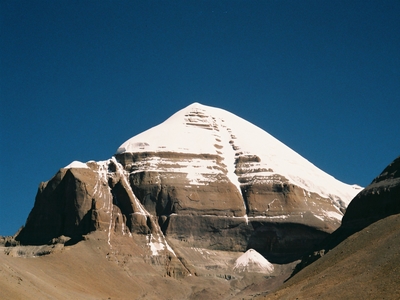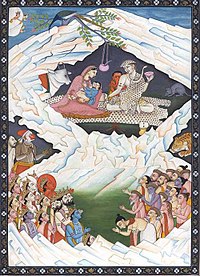| Revision as of 12:48, 7 August 2005 view sourceCALR (talk | contribs)Extended confirmed users16,048 editsm →In Hinduism: disambiguation link repair (You can help!)← Previous edit | Revision as of 06:19, 13 August 2005 view source FlaBot (talk | contribs)222,981 editsm robot Adding: de, frNext edit → | ||
| Line 44: | Line 44: | ||
| ] | ] | ||
| ] | ] | ||
| ] | |||
| ] | |||
| ] | |||
| ] | |||
Revision as of 06:19, 13 August 2005
Mount Kailash (also Mount Kailas or Kangrinbogê Feng 30.45N, 81.30E), at 6,718.2m (22,027 ft), is the tallest mountain on the Tibetan Plateau; excluding the Himalayan Range on the border of Tibet, it is the tallest mountain in Tibet. Kailash is the source of some of the longest rivers in Asia: the Indus River, the Sutlej River and the Brahmaputra River. The mountain lies near Lake Manasarowar and Lake Rakshastal.

Name
The word Kailas means "crystal" in Hindi. Tibetans call it Ghang Rimpoche or Khang Ripoche, meaning "precious jewel of snows". Other names for the mountain include Meru and Tise. Jainists refer to the mountain as Ashtapada.
Religious significance
In Hinduism

The ancient Aryans referred to Mount Kailas as Meru. They believed that at its peak was the paradisiacal city of Indra, the Vedic god of storms. The path to the city of Indra was the pathway of the stars, where dead souls stood among trees blossoming with flowers, awaiting rebirth. Some of the religious traditions of the ancient Aryans have been incorporated into modern Hinduism.
According to Hindu mythology, the god Shiva resides on the summit of Mount Kailash. The mountain is Shiva's linga and Lake Manasarowar below is the yoni of Shiva's wife.
According to the Puranas, Mount Kailas is the center of the world, and its four faces are made of crystal, ruby, gold, and lapis lazuli. It is the pillar of the world, 84000 leagues high, center of the world mandala, at the heart of six mountain ranges symbolizing a lotus. The four rivers flowing from Kailas then flow to the four quarters of the world and divide the world into four regions.
In Buddhism
The Tantric Buddhists believe that Kailas is the home of the Buddha Demchok (also known as Demchog or Chakrasamvara), who represents supreme bliss. It is said that Milarepa, champion of Tantric Buddhism, arrived in Tibet to challenge Naro-Bonchung, champion of the Bön religion of Tibet. The two magicians engaged in a terrifying sorcerous battle, but neither was able to gain a decisive advantage. Finally, it was agreed that whoever could reach the summit of Kailas most rapidly would be the victor. While Naro-Bonchung sat on a magic drum and soared up the slope, Milarepa's followers were dumbfounded to see him sitting still and meditating. Yet when Naro-Bonchung was nearly at the top, Milarepa suddenly moved into action and overtook him by riding on the rays of the sun, thus winning the contest and bringing Buddhism to Tibet.
Pilgrimage

Every year, thousands make a pilgrimage to Kailas, following a tradition going back hundreds of years. Pilgrims of several religions all believe that circumambulating Mount Kailas on foot is a holy ritual that will bring good fortune. The route is made in a clockwise direction by Hindus and Buddhists. Followers of the Jain and Bönpo religions circumambulate the mountain in a counterclockwise direction. The path around Mount Kailas is 52 kilometers (32 miles) long.
There are two schools of thought on walking around Mount Kailas. Some pilgrims believe that the entire walk around Kailas should be made in a single day. This is not easy; a person in good shape walking fast will take some 15 hours to complete the route due to uneven terrain, altitude sickness, and harsh conditions. Other pilgrims believe that the walk should be even more difficult. These pilgrims make the entire walk while performing body-length prostrations: The pilgrim bends down and kneels, rises and prays, and then crawls forward on hands and knees a few feet before repeating the process. Crawling 52 kilometers while performing prostrations is a daunting task that usually demands at least four days in the open. Pilgrims are not allowed to skip difficult parts, like frozen ground or streams. It is believed by the pilgrims that the greater the suffering, the greater the merit gained.
According to all religions that refer to the mountain, climbing it is a dire sin. Many people who have climbed it have died due to the dangerous obstacles one must pass.
When the People's Republic of China (PRC) invaded Tibet in 1950, Tibet was closed off to the outside world and the pilgrimages ceased. However, following improvement in Sino-Indian relations in 1979, the PRC began to re-allow pilgrimages to Mount Kailash.
References
- Nomachi, Kazuyoshi. Tibet. Boston: Shambhala, 1997.
- Thurman, Robert and Tad Wise, Circling the Sacred Mountain: A Spiritual Adventure Through the Himalayas. New York: Bantam, 1999. ISBN 0553378503 — Tells the story of a Western Buddhist making the trek around Mount Kailash.